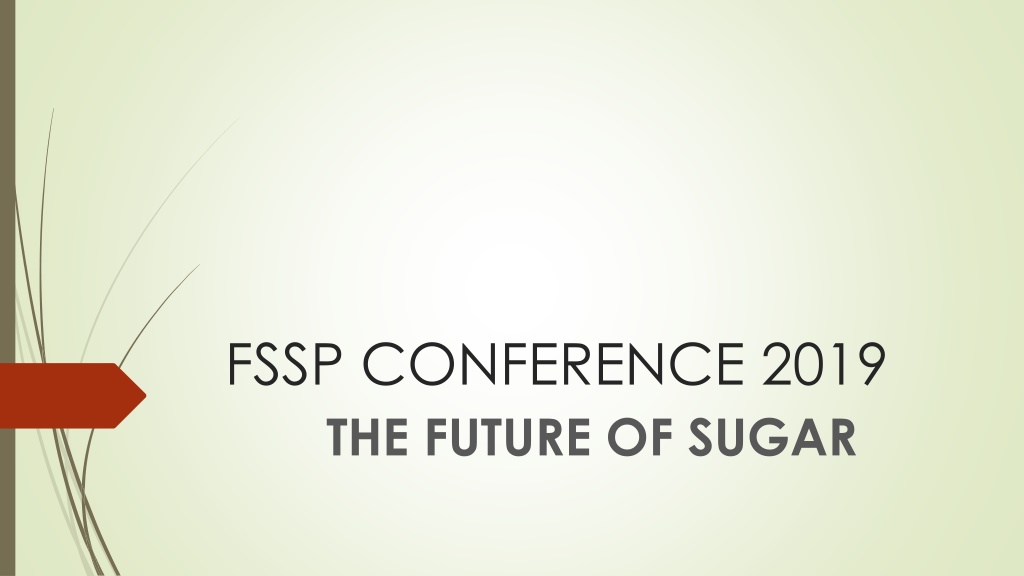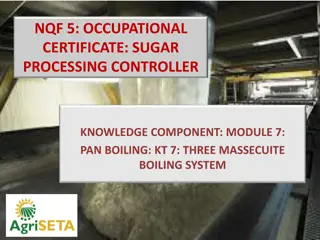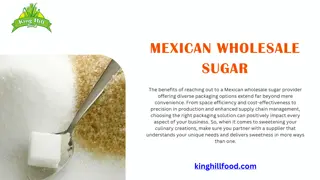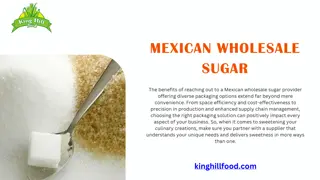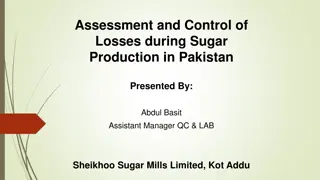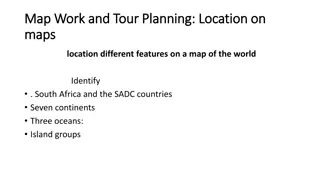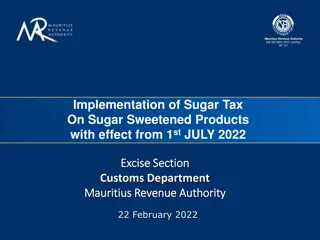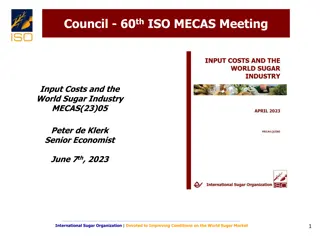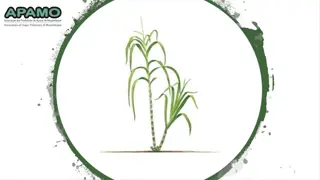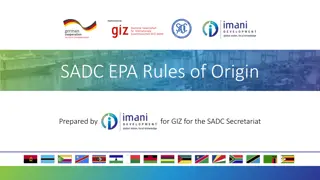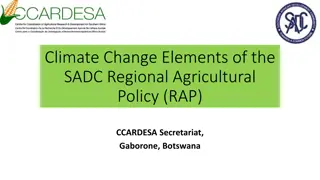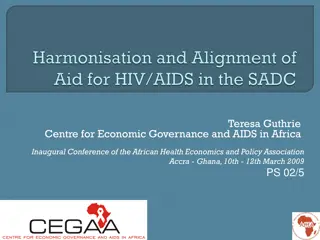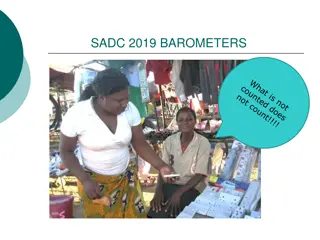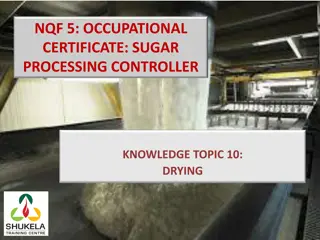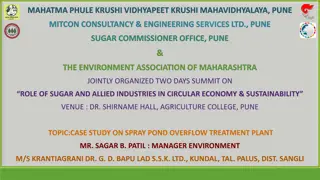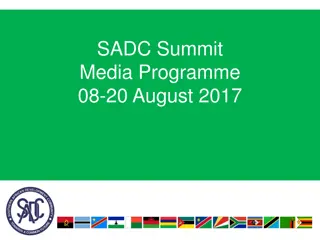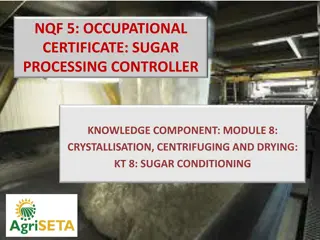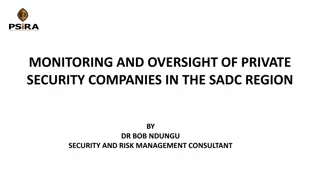The Future of Sugar Industry in SADC Region
The presentation at FSSP Conference 2019 highlighted the significance of the sugar industry in supporting economic development, employment creation, and poverty reduction in the SADC region. The industry plays a crucial role in driving industrialization, providing revenue and skills, and satisfying the sugar needs within SADC countries. Through supporting local communities and contributing to national GDP, the sugar sector emerges as a key component for sustainable growth in the region.
Download Presentation

Please find below an Image/Link to download the presentation.
The content on the website is provided AS IS for your information and personal use only. It may not be sold, licensed, or shared on other websites without obtaining consent from the author.If you encounter any issues during the download, it is possible that the publisher has removed the file from their server.
You are allowed to download the files provided on this website for personal or commercial use, subject to the condition that they are used lawfully. All files are the property of their respective owners.
The content on the website is provided AS IS for your information and personal use only. It may not be sold, licensed, or shared on other websites without obtaining consent from the author.
E N D
Presentation Transcript
FSSP CONFERENCE 2019 THE FUTURE OF SUGAR
The Sugar Sector as a Vehicle for Developing the Regional Economy Mr Sikhumbuzo Dlamini
Presentation Outline Importance of sugar industry in SADC. Trade within SADC How can sugar(cane) industry support drive to industrialise the sub-region? Conclusion
IMPORTANCE OF SUGAR IN SADC The sugar industry in SADC, is a key driver of economic development, through backward and forward linkages, supporting industrial development and sustainable economic growth. In one SADC country, the sugar industry represents roughly 6.1% of the country s GDP and 93% of the agricultural sector. Supporting local communities: The sugar cane industry also plays an important role in local communities, from helping establish small grower schemes to providing healthcare, education, housing and infrastructure. Building revenue and skills into the national economy: Sugar industries provide much needed export earnings and tax revenues to each host country, while the sugar production process supports the development of a range of engineering skills that transfer to other parts of the economy
IMPORTANT FOR EMPLOYMENT CREATION The sugar industry also contributes to poverty reduction in SADC. In one country, the poverty levels have dropped by over 4 per cent due in part to opportunities for rural people in the sugar industry.
SADC can satisfy its own sugar needs Production Cons Surplus/Deficit - - - - - - Angola DRC Eswatini Madagascar Malawi Mauritius Mozambique Namibia South Africa Tanzania Zambia Zimbabwe 49 333,33 71 666,67 644 930,33 87 951,33 266 317,00 366 202,00 381 666,67 336 333,33 281 666,67 55 000,00 186 939,33 240 223,67 30 920,67 206 666,67 86 289,33 1 938 864,67 557 421,67 189 650,67 322 800,33 4 432 777,00 287 000,00 210 000,00 589 930,33 98 988,00 26 093,33 335 281,33 175 000,00 86 289,33 303 997,00 243 323,67 176 460,33 96 039,67 169 207,00 - 1 634 867,67 314 098,00 366 111,00 418 840,00 4 601 984,00 *Averages for 2015-17 Source: ISO yearbook 2018
Average SADC Production Share 45.0 42.7 40.0 35.0 30.0 Percent (%) 25.0 20.0 13.0 15.0 9.8 9.4 8.8 10.0 6.8 4.9 5.0 2.1 1.3 0.7 0.3 0.1 0.0 Source: ISO yearbook 2018
Trade within SADC Intra-regional trade in Africa has for some years been an important center of discussion in the regional integration agenda And SADC is no exception to this topical issue; Most intra-regional trade tends to happen between developed nations and it is still small among African RECs; Despite numerous efforts by African Heads of States to promote intra-Africa trade, there has not been significant increase in intra-regional trade especially in Southern Africa.
Intra-SADC Trade Still Remains Very Low According to a study by OECD, July 2017, intra-SADC trade has increased slightly since the creation of the Free Trade Area (FTA) in 2008 with an estimated 85% of intra-regional trade subject to zero duty; According to that study, Intra-SADC trade hovers around 10%, and this is low compared to other regions like the South-East Asian Nations (at 24%) and the EU (at 40%); This implies that about 90% of SADC s trade is happening with external countries; [That s why the sugar industry contributes significantly to Forex] If any trade does happen within SADC, it could be influenced by South Africa which enjoys a significant trade influence in the region due to her economic size relative to the other member states within SADC; RSA s imports from SADC are low compared to its exports toward SADC countries, which creates a structural trade imbalance with the regional partners; This shows that there is a huge market in SADC since SADC region is a non- negligible market for RSA.
SADC Trades More With Rest of the World 250,000 200,000 180,000 200,000 160,000 140,000 150,000 Million US$ 120,000 Million US$ 100,000 100,000 80,000 60,000 50,000 40,000 20,000 - - 2006 2007 2008 2009 2010 2011 2012 2013 2014 2015 2006 2007 2008 2009 2010 2011 2012 2013 2014 2015 Intra-SADC Exports (FOB) Extra-SADC Exports (FOB) Intra-SADC Imports (CIF) Extra-SADC Imports (CIF) According to SADC Statistical Yearbook (2018), SADC tends to trade more with the rest of the world as depicted by both exports and imports; Intra-SADC Exports averaged $34.3 billion from 2006 to 2015 against $148.3 billion average in extra-SADC exports; The same applies for imports: Averaging $33.4 billion (intra) vs $144.6 billion (extra)
SADC Trades More With Rest of the World 250,000 200,000 150,000 Million US$ 100,000 50,000 - 2006 2007 2008 2009 2010 2011 2012 2013 2014 2015 (50,000) (100,000) Trade Balance Extra-SADC Exports (FOB) Extra-SADC Imports (CIF) SADC has relatively enjoyed a positive trade balance (surplus) with the rest of the world; This implies that SADC exports more than it imports from RoW save for 2009, 2012, 2014 and 2015 when trade deficits were recorded.
SADC Trades More With Rest of the World EXPORT PROPORTIONS BY AFRICAN REGION, 2012-2014 Russian Fed. 0,21 0,00 0,15 0,00 COMESA 16,55 51,80 9,31 4,96 EAC 5,54 21,34 2,31 0,00 SADC 13,80 0,02 5,51 0,00 17,81 0,61 6,23 8,33 ROA Aus. 0,00 0,00 0,75 0,00 EU 49,48 0,08 38,20 18,50 India 0,11 0,00 0,17 0,00 US 1,18 0,00 1,77 0,00 ROW 13,12 100,00 21,26 100,00 28,90 100,00 61,98 100,00 TOTAL COMESA EAC SADC ROA IMPORTS BY AFRICAN REGION, 2012-2014 COMESA 9,56 2,07 7,48 0,59 0,00 40,90 0,04 3,30 13,73 11,30 0,00 11,03 100,00 EAC 20,19 5,38 11,72 0,00 0,00 1,79 0,00 0,77 1,82 12,57 0,00 45,76 100,00 SADC 8,97 0,25 16,10 0,84 0,00 19,12 0,00 0,17 1,64 27,69 0,10 25,11 100,00 100,00 ROA 0,01 0,00 0,31 0,64 0,02 75,86 0,00 3,65 3,79 1,98 0,24 13,51 COMESA EAC SADC ROA Australia Brazil Cuba EU India Thailand USA RoW Total
SADC Sugar Exports Low Relative To World According to ISO Year Book (2018), SADC Member States are lagging behind on the production of and trading in sugar; This is shown by the proportion of SADC sugar trade as a share of world sugar trade which hovers below 5% from 2011 to 2017; The trend has been deteriorating towards the latter years, reaching a low of 2.6% in 2016 before rising to 3.0% in 2017. SADC Sugar Exports AS % of World 5.0% 4.6% 4.5% 4.3% 4.2% 4.0% 3.9% 3.5% 3.3% 3.0% 3.0% Percent 2.6% 2.5% 2.0% 1.5% 1.0% 0.5% 0.0% 2011 2012 2013 2014 2015 2016 2017
Collectively, Average For SADC Countries Exports of Sugar Relative To Total Exports Still Very Low Drilling down to SADC Member States indicates that even their average share of sugar exports to total exports are not very impressive (below 8%); With the exception of Mauritius, Eswatini and Malawi which have sugar exports accounting for 15.2%, 14.8%, and 8.4% respectively to their total exports; And this could be due to their small size of their economies. Average SADC Sugar Exports as Share of MS Exports 8.0% 7.3% 7.0% 7.0% 6.1% 6.0% 5.2% 5.0% 4.7% 4.6% Percent 4.0% 3.0% 2.0% 1.0% 0.0% 2011 2012 2013 2014 2015 2016
Southern Africa has an integration plan: but its short of sector specifics* The Southern African Development Community (SADC) has placed industrialisation at the centre of its regional integrated development plan and a roadmap has been drawn up to guide the plan. But implementation has been poor and not a lot of headway has been made to integrate the economies of the region. Recent studies on value chains in the region highlight high transport costs and continued use of non-tariff barriers in some countries as some of the main reasons for poor progress. These studies suggest that the region needs a coherent sector-specific approach to support the development of regional value chains. That should be supported by efforts to reduce trade barriers. In addition, the impact on industrialisation that large multinationals have had should be considered. *Pamela Mondliwa, Researcher, Centre for Competition, Regulation and Economic Development, University of Johannesburg
Southern Africa has an integration plan: but its short of sector specifics .cont d This is where the sugar (sugarcane) industry comes in. The importance of developing regional value chains is more critical than before, if the region is to benefit from investments in the sugar industry. The FSSP should prioritise developing a regional roadmap to industrialise the sugarcane industry. This would help attract investments and ensure the region reaps the benefits of the Continental Free Trade Area.
Beneficiation is key The industrialisation strategy stresses the urgent need for the region to make use of its abundant and diverse resources particularly in agriculture and mining. Its key aim is to foster industrialisation through beneficiation a process of transforming primary raw materials into a more value added finished product and value addition. This approach is informed by two big challenges related to trade. First, is that intra-regional trade is low. And that trade between countries is dominated by low value products. There is a need to develop regional value chains - only a regional approach to promoting value addition will work. It must focus on building productive capacity of industries, developing infrastructure and promoting technology.
Value addition is the answer Over the year, more and more sugar industries are transforming to co- produce sugar, ethanol and electricity and other by-products. World s two largest cane producers, Brazil and India, have access to sugar, regulated electricity and ethanol markets. With the current huge deficit in the SADC power pool, there is an urgent need for co-generation. Expanding the production of clean renewable sugarcane products may have the potential to enhance energy security and create jobs. In addition, there are opportunities for bioplastics, bio-hydrocarbons and biochemical.
Beneficiation is the key there is a lot more to the sugar industry Further products Ethanol and spirits By Products OK sugar , then what? Molasses Bagasse Disposable packs Pellets for fuel Filter Mud Writing paper Cane wax Animal Feed
Some key take aways INNOVATION and a firm grasp of international trends linked to climate change and consumer demand are key if SADC sugar producers are to enjoy sustained growth in the face of rising costs, unpredictable weather patterns and the global anti-sugar lobby. ANTI-SUGAR LOBBY IMPACTS ARE REAL the demand trends are influenced by sponsored lobbyist who want many to believe sugar is bad! BENEFICIATION would have a positive impact on key macroeconomic variables in most of the SADC economies, i.e. foreign exchange, GDP, employment, trade creation, etc. The future of the sugar industry is a vibrant sugarcane industry embracing diversification, innovation and cost efficiencies.
